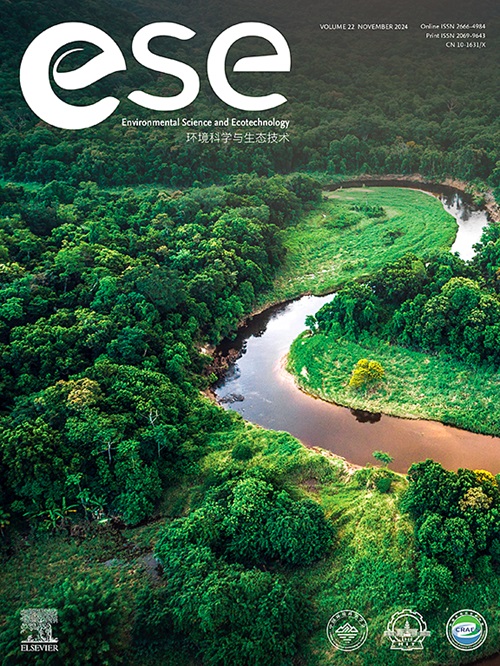How soon will landfilled plastics integrate into the geological carbon cycle?
IF 14
1区 环境科学与生态学
Q1 ENVIRONMENTAL SCIENCES
引用次数: 0
Abstract
Approximately half of plastic waste ends up in landfills, where fragmentation leads to the leakage of microplastics, nanoplastics, and petrogenic carbon back into ecosystems. However, the timeframe for plastic re-entry into the geological carbon cycle remains unknown. Using landfill-derived field data, we developed a model predicting fragmentation of various polymers into macroplastics, microplastics, fine microplastics, and nanoplastics. We find total waste plastic concentrations range from 85 to 414 mg g−1, with microplastic, fine microplastic, and nanoplastic generation rates of 2–69, 0.5–36.8, and 0.04–1.9 mg per g of plastic, respectively. Plastic distribution depends more on landfill depth than disposal age. Polyethylene terephthalate fragments faster than polypropylene or polyethylene. Our model predicts peak microplastic and fine microplastic fractions within 157–382 and 412–2118 years, respectively, with approximately half of the plastic-derived carbon available for geological cycling in 80–208 years. This research helps clarify the environmental fate of pervasive plastic pollution.

填埋的塑料要多久才能融入地质碳循环?
大约一半的塑料垃圾最终被填埋,在那里,碎片化导致微塑料、纳米塑料和岩石碳泄漏回生态系统。然而,塑料重新进入地质碳循环的时间框架仍然未知。利用垃圾填埋场的现场数据,我们开发了一个模型,预测各种聚合物分裂成宏观塑料、微塑料、细微塑料和纳米塑料。我们发现废塑料的总浓度范围为85至414 mg g - 1,微塑料、细微塑料和纳米塑料的生成率分别为2-69、0.5-36.8和0.04-1.9 mg / g塑料。塑料的分布更多地取决于填埋场的深度,而不是处理时间。聚对苯二甲酸乙二醇酯碎片比聚丙烯或聚乙烯快。我们的模型预测微塑料和细微塑料的峰值分别在157-382年和412-2118年,大约一半的塑料衍生碳在80-208年可用于地质循环。这项研究有助于澄清普遍存在的塑料污染的环境命运。
本文章由计算机程序翻译,如有差异,请以英文原文为准。
求助全文
约1分钟内获得全文
求助全文
来源期刊

Environmental Science and Ecotechnology
Multiple-
CiteScore
20.40
自引率
6.30%
发文量
11
审稿时长
18 days
期刊介绍:
Environmental Science & Ecotechnology (ESE) is an international, open-access journal publishing original research in environmental science, engineering, ecotechnology, and related fields. Authors publishing in ESE can immediately, permanently, and freely share their work. They have license options and retain copyright. Published by Elsevier, ESE is co-organized by the Chinese Society for Environmental Sciences, Harbin Institute of Technology, and the Chinese Research Academy of Environmental Sciences, under the supervision of the China Association for Science and Technology.
 求助内容:
求助内容: 应助结果提醒方式:
应助结果提醒方式:


